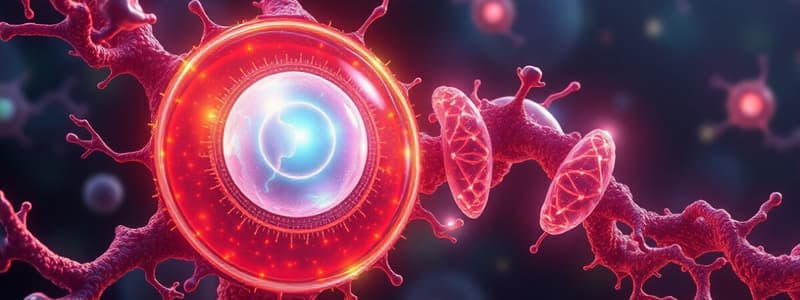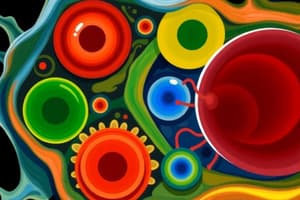Podcast
Questions and Answers
Which of the following is classified as a hydantoin used for treating seizures?
Which of the following is classified as a hydantoin used for treating seizures?
- Lamotrigine
- Phenytoin (correct)
- Clonazepam
- Ethosuximide
What characteristic of phenytoin is highlighted as optimal for its activity?
What characteristic of phenytoin is highlighted as optimal for its activity?
- Hydroxyl groups
- Bulky C5 substitution (correct)
- Presence of a carbonyl group
- Aromatic benzene rings
Which drug is classified under oxazolidinediones?
Which drug is classified under oxazolidinediones?
- Trimethadione (correct)
- Phenobarbital
- Felbamate
- Zonisamide
Which of the following is primarily a GABA analog?
Which of the following is primarily a GABA analog?
What is the primary mechanism of action for anti-seizure drugs?
What is the primary mechanism of action for anti-seizure drugs?
Which agent is NOT typically used for myoclonic seizures?
Which agent is NOT typically used for myoclonic seizures?
Which of the following anti-seizure drugs is known for its additional uses in neuropathic pain?
Which of the following anti-seizure drugs is known for its additional uses in neuropathic pain?
What class of drugs does phenobarbital belong to?
What class of drugs does phenobarbital belong to?
What is a major advantage of fosphenytoin compared to traditional phenytoin?
What is a major advantage of fosphenytoin compared to traditional phenytoin?
Which characteristic of oxazolidinedione (trimethadione) contributes to its activity against petit mal seizures?
Which characteristic of oxazolidinedione (trimethadione) contributes to its activity against petit mal seizures?
What is the mechanism of action for valproic acid?
What is the mechanism of action for valproic acid?
What is the primary metabolic pathway for ethosuximide?
What is the primary metabolic pathway for ethosuximide?
Which of the following statements is true regarding gabapentin and pregabalin?
Which of the following statements is true regarding gabapentin and pregabalin?
What critical effect does lamotrigine have in managing seizures?
What critical effect does lamotrigine have in managing seizures?
Which methylxanthine is primarily known to act as a CNS stimulant?
Which methylxanthine is primarily known to act as a CNS stimulant?
What is a notable side effect of felbamate that limits its use?
What is a notable side effect of felbamate that limits its use?
Which mechanism is NOT associated with the action of Anti-Parkinson drugs?
Which mechanism is NOT associated with the action of Anti-Parkinson drugs?
What is the primary therapeutic use of Levadopa in treating Parkinson's Disease?
What is the primary therapeutic use of Levadopa in treating Parkinson's Disease?
Which of the following drugs acts as a DA agonist in the treatment of Parkinson's Disease?
Which of the following drugs acts as a DA agonist in the treatment of Parkinson's Disease?
The therapeutic effect of Amantadine in Parkinson's Disease is primarily due to its role as a:
The therapeutic effect of Amantadine in Parkinson's Disease is primarily due to its role as a:
Which treatment option specifically targets the inhibition of COMT in Parkinson's Disease management?
Which treatment option specifically targets the inhibition of COMT in Parkinson's Disease management?
Anticholinergics are primarily effective in managing which symptom of Parkinson's Disease?
Anticholinergics are primarily effective in managing which symptom of Parkinson's Disease?
Selegiline and Rasagiline both act as:
Selegiline and Rasagiline both act as:
Which neurotransmitter's deficiency is primarily responsible for the symptoms of Parkinson's Disease?
Which neurotransmitter's deficiency is primarily responsible for the symptoms of Parkinson's Disease?
Flashcards are hidden until you start studying
Study Notes
Anti-Seizure Drugs: Old Agents
- Hydantoins: Phenytoin and Fosphenytoin
- SAR: Activity increased by bulky C5 group, phenytoin's 5,5-diphenyl structure leads to maximum activity
- Metabolism: Primarily via CYP3A4 (N-demethylation, N-oxidation), also CYP2D6 (aromatic hydroxylation)
- Adverse Effects: Sedation, associated with 5-HT2 and 5-HT3 antagonism
Oxazolidinedione (Trimethadione)
- SAR: Lack of bulky C5 groups eliminates grand mal activity, but increases petit mal (absence seizure) activity
- High toxicity limits its therapeutic use.
Succinimide (Ethosuximide)
- Drug of choice for absence seizures (petit mal)
- SAR: No bulky C5 group, replaces -O- (in oxazolidinedione) with -CH2, resulting in safer drug with retained activity
- Metabolism: ~20% excreted unchanged, via CYP 3A4 and 2E1
Valproic acid
- Used for both grand and petit mal seizures
- MOA: Promotes GABA transmission by inhibiting GABA metabolism; blocks VGSC, decreasing neuronal firing
- Adverse Effects: Limited use due to rare hepatotoxicity and teratogenicity
Anti-Seizures: New Agents
Iminostilbene (Carbamazepine)
- SAR: 2 phenyl groups are essential for activity, substitutions at C10 (keto, hydroxy, acetate ester) result in less potent but still active compounds
- MOA: Inactivation of excessive neuronal firing by VGSC blockade
- Note: Derivatives of TCAs (tricyclic antidepressants)
GABA Analogs (Gabapentin and Pregabalin)
- SAR: Both are analogs of GABA (inhibitory neurotransmitter)
- MOA: Regulates Ca+2 influx via VGCC, activating GAD (glutamic acid decarboxylase) to inhibit glutaminergic neurotransmission
- Metabolism: Minimal
Phenyltriazine (Lamotrigine)
- Useful for grand mal, petit mal, and partial seizures in adults
- MOA: Blocks VGSC and VGCC, stabilizing presynaptic neurons; inhibits glutamate release, preventing excitatory response
- Metabolism: Glucuronidation
Dicarbamate (Felbamate)
- Potent and widely used, but associated with severe adverse effects: aplastic anemia and hepatic failure
- MOA: Interacts with NMDA, decreasing glutamate transmission and reducing neuronal excitation
- Metabolism: Via ester hydrolysis and oxidation
CNS Stimulants
Methylxanthines
- Xanthine derivatives found in plants, act as CNS stimulants.
Epilepsy
- Disorder characterized by recurrent seizures, not caused by identifiable factors.
Seizures
- Symptom of disturbed electrical activity in the brain
Generalized Seizures
- Absence (petit mal): Brief loss of awareness, blank stare, postseizure amnesia, no loss of motor activity.
- Myoclonic: Short duration, no loss of consciousness, involves muscular jerks.
- Tonic-Clonic (grand mal): Bilateral muscle jerking, loss of consciousness, tonic-clonic spasms
Partial Seizures
- Simple: Affects an entire hemisphere or a lobe of the brain.
- Complex: Temporal/psychomotor seizures, can be mistaken for psychotic behavior.
MOA of Anti-Seizure Drugs
- Drugs alter ion channel or receptor function to promote synaptic inhibition or modulate synaptic excitation.
Sites of Action for Anti-Seizure Drugs
Glutamate Presynaptic Neuron
- Lamotrigine
- Ezogabine
- Ethosuximide
- Valproate
- Zonisamide
- Benzodiazepines
- Carbamazepine
- Lamotrigine
- Lacosamide
- Oxcarbazepine
- Phenobarbital
- Phenytoin
- Rufinamide
- Topiramate
- Valproate
- Zonisamide
GABA Presynaptic Neuron
- SSAH
- GAD
- GABA-T
- Vigabatrin
- Benzodiazepines
- Phenobarbital
- Topiramate
- Valproate
- Tiagabine
- Topiramate
- Felbamate
Partial and Generalized Tonic-Clonic Seizures
- Benzodiazepines
- Carbamazepine
- Ezogabine
- Lacosamide
- Felbamate
- Oxcarbazepine
- Phenobarbital
- Phenytoin
- Pregabalin
- Primidone
- Rufinamide
- Tiagabine
- Topiramate
- Vigabatrin
Myoclonic Seizures
- Felbamate
- Lamotrigine
- Levetiracetam
- Valproate
- Zonisamide
- Gabapentin
- Clonazepam
- Topiramate
Absence Seizures
- Ethosuximide
- Methosuximide
- Trimethadione
Anti-Parkinson Drugs
-
Parkinson's Disease (PD): Slowly progressive, neurodegenerative disorder affecting the extrapyramidal dopaminergic pathway
-
Clinical Manifestations:
- Resting tremor (improved by voluntary activity)
- Bradykinesia (slow initiation and paucity of voluntary movements)
- Muscle and joint rigidity (postural disturbances)
-
Treatment:
- L-A-B-A-S-E drugs and related substances: Levadopa, Amantadine, Bromocriptine, Anticholinergics, Selegiline, Entacapone
Normal vs Parkinsonism
- Normal: Substantia nigra, Corpus striatum, Dopamine, Acetylcholine, GABA
- Parkinsonism: Lack of dopamine, resulting in deficient DA neurotransmitter; lack of direct stimulation for thalamus modulation (responsible for excitatory outflow to motor cortex).
Anti-Parkinsonism
- Drugs and Mechanism of Action:
- Lipophilic DA Precursor: Levadopa (dopamine precursor)
- DA Agonist and Reuptake Inhibitor: Amantadine
- DA Agonists: Bromocriptine, Pergolide, Pramipexole
- Anticholinergics: Treat tremor (Benztropine, Biperiden, Trihexypeħnidyl)
- MAO-B Inhibitors: (Without hypertensive crisis): Selegeline and Rasagiline
- COMT Inhibitors: Entacapone and Tolcapone
Studying That Suits You
Use AI to generate personalized quizzes and flashcards to suit your learning preferences.



